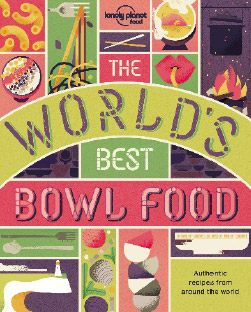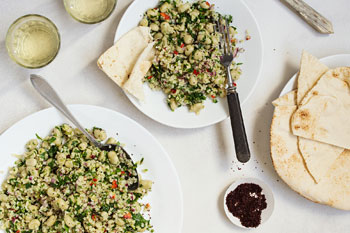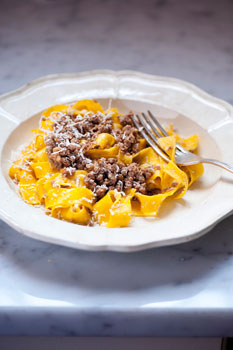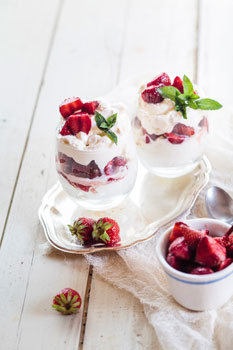Lonely Planet Food's The World's Best Bowl Food

Discover 100 one-pot recipes from cultures around the globe with Lonely Planet Food's The World's Best Bowl Food.
The new book is divided into six chapters:
Breakfast Bowls
Soups
Salads & Healthy Bowls
Rice, Pasta & Noodles
Stews, Braises & Hearty Bowls
Desserts
46 destinations are represented in the book, with recipes that will set you up for the day, warm the core or humbly feed friends and family. Explore the culture and cooking methods behind the planet's most comforting meals with recipes for dishes such as Beouf bourguignon (France), Bibimbap (Korea), Red bean tagine (Morocco), Waldorf salad (USA) and Eton mess (England). All recipes in the book are rated easy, medium or hard to re-create and include tasting notes and information about the origins of the dish.
It's no coincidence that some of the world's very best edible offerings come in a bowl. There's just something hearty, wholesome and inviting about spheres of steaming soup, colourful poké, and aromatic pho that plating up can't match, so get ready and dig in!
This is the fifth release in Lonely Planet Food's The World's Best… series of food & drink books, following The World's Best Street Food (2012), The World's Best Spicy Food (2014),The World's Best Drinks (2016) and The World's Best Superfoods (2017).
Lonely Planet Food's The World's Best Bowl Food
Lonely Planet
RRP: $24.99
 Persian Spiced Cauliflower and Bulgur Salad – UK
Persian Spiced Cauliflower and Bulgur Salad – UK
An intellectual feast for the eyes and the tastebuds, this Middle Eastern-inspired salad is a playground of unusual ingredients and vivid flavours.
Serves 4
Ingredients
2 tbs olive oil
1 tbs sumac
1 tbs za'atar
salt
1 cup bulgur wheat
½ cup buttermilk
juice of ½ a lemon
1 tbs pomegranate molasses, plus extra for drizzling
2 celery sticks, sliced thinly crosswise
½ cup dried dates, chopped
¼ cup pomegranate seeds
1 cup mixed soft herbs such as dill, mint and parsley
warm pita, to serve
1 tomato, thinly sliced
Method
In a large bowl, mix the cauliflower florets, 1 tbs of the olive oil, sumac and za'atar with your hands, making sure each floret is coated evenly with the oil and spices.
Heat the remaining oil in a grill or frying pan. Without crowding the pan, fry the cauliflower in batches, turning the florets every few minutes until they are golden brown on all sides.
Set the fried cauliflower aside on paper towels and season with salt.
Cook the bulgur according to packet instructions and set aside.
To make the dressing, whisk together the buttermilk, lemon juice and pomegranate molasses in a large bowl. Season to taste.
Add the cauliflower, bulgur, celery, dates, pomegranate seeds and herbs to the bowl and toss well.
To serve, line each of four bowls with three small pita wedges, add the salad and top with the tomato slices and a drizzle of pomegranate molasses.
Authentic Middle Eastern recipes can evoke fear among even competent home cooks, dreading the demands of an ingredients list that might include hard-to-find items such as kohlrabi or Iranian limes. Those who persevere, however, are rewarded with dinner-party impressive and simply delicious dishes. Humble vegetables such as celeriac and broccoli are magically transformed by an array of spices and herbs into an explosion of contrasting yet harmonious flavours – moreish, zesty and satisfying. Best of all, these dishes are often just as good straight from the stove or at room temperature, making them perfect for just about any occasion, from sit-down meals and office lunches to alfresco dining and picnics.
Origins
Well before the term -superfood' was a buzzword and healthy eating became a lifestyle brand, London-based chef and writer Yottam Ottolenghi was extolling the virtues of vegetables without excluding meat. Championing ingredients both unglamorous and exotic, such as eggplant, cauliflower and sumac, Ottolenghi's signature style of complex flavours, colourful dishes and above all, always tasty food undeniably changed the British food scene, just as Julia Child brought home-cooked French cuisine to America.
 Tagliatelle al ragu – Italy
Tagliatelle al ragu – Italy
When you go to Bologna, where the dish known and loved as -spaghetti Bolognese' was invented, you'll find a slightly different manifestation of what may be the world's favourite bowl of comfort.
Serves 2
Ingredients
1 tbs butter
140g (5oz) pancetta, cut into small cubes
2 celery sticks, finely chopped
1 small carrot, peeled and finely chopped
½ small onion, peeled and finely chopped
300g (10½oz) ground beef
½ cup dry white wine
5 tsp tomato paste
1 cup whole milk
salt and pepper, to taste
fresh egg tagliatelle
Method
Melt the butter in a pan and add the pancetta. Cook gently until the fat has rendered, about 10 minutes.
Add the celery, carrot and onion and cook, stirring frequently, until soft and lightly browned, about 15 minutes.
Add the ground beef and cook while stirring, until lightly browned and starting to sizzle.
Add wine and cook until evaporated, about 5 minutes.
Mix the tomato paste with a little water and add to the pan.
Reduce the heat to low and simmer for 2 hours, stirring occasionally, adding the milk little by little and adjusting the seasoning.
Bring some salted water to a boil in a large pan and cook the tagliatelle until al dente.
Toss the pasta with the ragù and serve with the parmesan.
Tasting Notes
Here in Bologna – -la Grassa' (the Fat One) – beats Italy's gastronomic heart. The immense popularity of its most famous dish has led to infinite variations so, in a bid to establish first principles, in 1982 the Bolognese chamber of commerce set down an official recipe (our recipe here hews closely to it). While it may surprise some (no tomatoes! milk?) it's more like what you'll find in a Bolognese kitchen than in the world's red-sauce restaurants – an umami bomb of meatiness, concentrated by long, slow cooking and transported perfectly by silky smooth egg pasta. To try it at its best, get yourself invited to the home of a local nonna. If that fails, choose a traditional trattoria and make sure you ask for tagliatelle al ragù – not spaghetti Bolognese.
Origins
Meaty sauces date back to Roman times, but it was the Gauls who transformed the recipe into something similar to what we know today. These early ragù dishes were tomato-free – that would come with the arrival of tomatoes in Europe from the New World in the 16th century. As for the pasta, serving ragù with spaghetti (made from durum wheat and originating in Naples) is unheard of in the hometown of -spag bol', where it's served with wide, flat tagliatelle made from fresh eggs.
 Eton Mess – England
Eton Mess – England
A quintessentially English summer dessert, Eton mess is a glorious combination of crushed meringue, fresh strawberries and whipped cream best served outdoors on a sunny day.
Serves 4
Ingredients
2 egg whites
100g (3½oz) caster (superfine) sugar (plus extra)
1⅔ cups double (heavy) cream
450g (1lb) strawberries
Method
Preheat the oven to 120°C (250°F).
Line a baking sheet with parchment paper.
Whisk the egg whites until stiff. Gradually add the sugar, a tablespoon at a time, and mix until thick and glossy.
Put 6 heaped spoonfuls of the egg mixture on to the baking tray. Place into the oven and bake for 90 minutes.
Turn off the oven, leaving the meringues inside until completely cooled.
Whip the cream lightly and sweeten to taste with more sugar.
Crush half of the strawberries to a pulp, then cut the other half into quarters.
Break the meringues into small pieces in a large bowl. Add the cream and crushed strawberries and mix gently.
Divide the mixture into four smaller bowls and garnish with the remaining strawberries.
Tasting Notes
The success of this dish is largely due to its delicious jumble of textures, crispy yet chewy meringue, rich cream and succulent strawberries. It's a true crowd-pleaser that suits all age groups, can be whipped up in an instant (if you opt for shop-bought meringues), and is easily transportable. Somehow its slapdash presentation and simple flavours embody all that is wonderful about languid summer days spent strolling through parks or along sunny riverbanks, revelling in the warmth. Whether you just nip into the back garden on a summer's evening or lay out your spread on a Barbour picnic blanket by the cricket field, a big bowl of Eton mess adds a touch of glamour. Just beware of Labradors.
Origins
In one of the culinary world's best origin tales, legend has it that Eton mess was born when an over-excited Labrador sat on a picnic basket and crushed a strawberry pavlova. Whatever its history, the dish was seemingly on sale in the tuck shop of England's most prestigious public (which, confusingly, actually means private) school, Eton College, in the 1930s and was served at important cricket matches and open days. How it got into the hands of the riff -raff remains a mystery.
Lonely Planet Food's The World's Best Bowl Food
Lonely Planet
RRP: $24.99
Persian Spiced Cauliflower and Bulgur Salad Image Credit: ©Andrew Riverside/Shutterstock
Tagliatelle Al Ragu Image Credit: ©Susan Wright/Lonely Planet
Eton Mess Image Credit: ©Westend61/Getty Images
MORE



